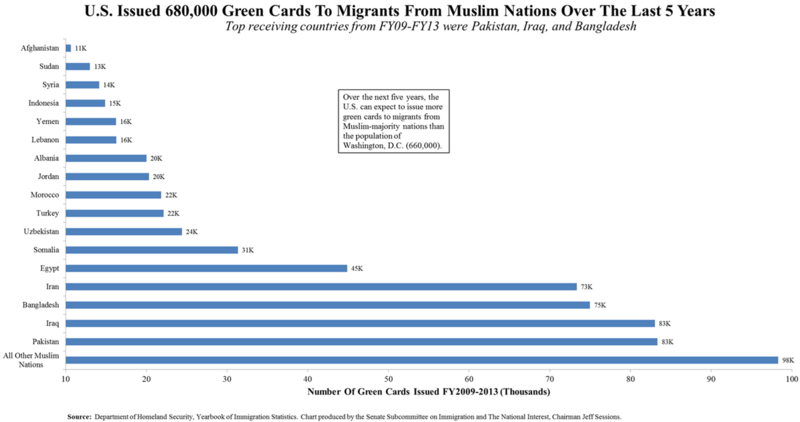
Subcommittee chart: U.S. issued 680,000 green cards to migrants from Muslim nations over the last five years
By Senator Jeff Sessions
Background from the Subcommittee on Immigration and the National Interest:
According to published Department of Homeland Security (DHS) data, the U.S. issued 680,000 green cards to migrants from Muslim-majority countries in the five-year period from FY2009 through FY2013. Among those receiving green cards are individuals admitted to the United States as refugees, who must apply for adjustment to Lawful Permanent Resident (green card) status within 1 year of admission. Refugees have instant access to federal welfare and entitlements, along with local benefits and education services; these costs are not offset.
680,000 is not an estimate of total migration, as it does not include temporary migrants who return home, nor is it an estimate of population change, as it does not include births or deaths, among other considerations. Assuming no change in visa policy, the U.S. can expect to give green cards to another 680,000 more migrants from these countries over the next five years. A green card entitles recipients to access federal benefits, lifetime residency, work authorization, and a direct route to becoming a U.S. citizen.
The numbers could be higher still: Census Bureau data shows migration from the Middle East to be one of the fastest-growing categories. Additionally, if left in place, the President’s refugee plan would substantially boost the annual number of migrants from this region admitted to the U.S. who, in turn, would be able to petition for their relatives to migrate to the U.S. in the future. Refugee and asylee admissions from Iraq, Somalia, and Iran alone contributed 124,000 individuals from FY09-FY13.
Green Card Totals, FY09-FY13:
Pakistan (83K), Iraq (83K), Bangladesh (75K), Iran (73K), Egypt (45K), Somalia (31K), Uzbekistan (24K), Turkey (22K), Morocco (22K), Jordan (20K), Albania (20K), Lebanon (16K), Yemen (16K), Indonesia (15K), Syria (14K), Sudan (13K), Afghanistan (11K), Sierra Leone (10K), Guinea (8K), Senegal (7K), Saudi Arabia (7K), Algeria (7K), Kazakhstan (7K), Kuwait (5K), Gambia (5K), United Arab Emirates (4K), Azerbaijan (4K), Mali (3K), Burkina Faso (3K), Kyrgyzstan (3K), Kosovo (3K), Mauritania (2K), Tunisia (2K), Tajikistan (2K), Libya (2K), Turkmenistan (1K), Qatar (1K), Chad (1K)
[Note: These are the specific DHS green card totals during this time range for Muslim-majority countries which sent at least one-thousand or more migrants, and include any refugees or asylees who adjusted to LPR status.]
Numerical Context:
According to the U.S. Census Bureau, the foreign-born population in the United States is at a record 41.3 million. One-quarter of the U.S. population is now either foreign-born or has foreign-born parents. The Census Bureau projects the percentage of the population born outside the country will soon pass the highest percentage ever recorded and continue rising to new all-time records never before witnessed – unless Congress passes a law to reduce green card allotments. Without such changes, the Census Bureau projects that, for each coming year the total number of immigrants in the United States will increase, the annual rate of immigrant admissions will increase, and the foreign-born share of the population will increase. Pew polling data shows that 83% of the public (across all parties) opposes this baseline and believes the level of immigration should either be frozen or reduced. By a nearly 10-1 margin, Americans of all backgrounds are united in their shared belief that companies with positions to fill should raise wages instead of bringing in new lower-wage labor from abroad. And yet, despite this, the Senate’s Gang of Eight bill would have tripled the issuance of green cards over the next decade, and this year’s I-Squared bill would substantially increase both low-wage guest worker admissions and green card allotments – all on top of the existing record-breaking and unprecedented growth in future immigration.
In a recent op-ed calling for immigration reductions, Chairman Sessions observed:
“In 1970, one in 21 U.S. residents were immigrants. Today, it is nearly one in seven. Fifty-nine million immigrants have been admitted into the USA since the passage of visa changes enacted in 1965. Largely, this immigration growth is the green cards.
This large-scale migratory flow has padded the labor supply and pushed down wages for immigrant and U.S.-born workers alike. Real wages today are lower than they were in 1973.
After the numerically smaller immigration wave from 1880 to 1920, Congress reduced immigration for nearly the next half-century. This migratory pause helped both U.S.-born and foreign-born already living here climb into the middle class.
But now, unlike then, the Census Bureau projects we are going to stack another record five-decade immigration wave on top of the last five-decade immigration wave — for 100 years of uninterrupted record-breaking immigration. According to Pew Research, new immigrants and their future children will add 103 million to the U.S. population over the next 50 years — or the population equivalent of more than 25 cities the size of Los Angeles.
This is extreme.
Eighty-three percent of voters want to see projected immigration growth reduced — which means Congress must take up and pass a bill to reduce the number of visas handed out each year.”
http://www.sessions.senate.gov/public/index.cfm/2015/11/subcommittee-chart-u-s-issued-680-000-green-cards-to-migrants-from-muslim-nations-over-the-last-five-years








